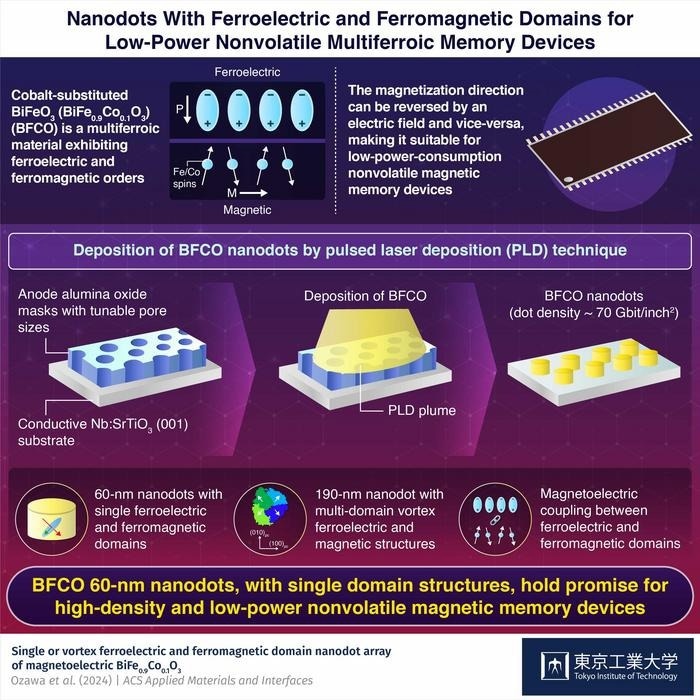Researchers at the Tokyo Institute of Technology used pulsed laser deposition to install multiferroic BFCO onto a conductive Nb: SrTiO3 (001) substrate, according to a study published in the journal ACS Applied Materials and Interfaces. They used anodized aluminum oxide (AAO) masks with adjustable pore sizes to regulate the deposition process, producing nanodots with diameters ranging from 60 to 190 nm.
 BFCO 60-nm nanodots, with single domain structures, hold promise for high-density and low-power nonvolatile magnetic memory devices. Image Credit: Tokyo Tech
BFCO 60-nm nanodots, with single domain structures, hold promise for high-density and low-power nonvolatile magnetic memory devices. Image Credit: Tokyo Tech
Traditional memory devices are volatile, whereas non-volatile ones store data in ferromagnetic or ferroelectric materials. Data is recorded or stored in ferromagnetic devices by aligning magnetic moments, whereas data storage in ferroelectric devices is based on electric dipole alignment.
However, creating and controlling magnetic fields requires a lot of energy, and reading data in ferroelectric memory devices destroys the polarized state, forcing the memory cell to be rewritten.
Ferroelectric and ferromagnetic orders coexist in multiferroic materials, which provides a possible avenue for more effective and adaptable memory technology. BiFe0.9Co0.1O3, also known as BFCO, is a multiferroic material with significant magnetoelectric coupling, which means that variations in electric polarization impact magnetization.
Instead of creating magnetic fields that use more energy, data can be written and read using electric fields, eliminating the need for the destructive read-out procedure.
A group of scientists from the Tokyo Institute of Technology in Japan, led by Professor Masaki Azuma and Assistant Professor Kei Shigematsu, have created nanodots with single ferroelectric and ferromagnetic domains, which is a major advancement for multiferroic memory systems.
At ‘Sumitomo Chemical Next-Generation Eco-Friendly Devices Collaborative Research Cluster’ within the Institute for Innovative Research at Tokyo Institute of Technology, there is a focus on multiferroic materials that exhibit cross-correlation responses between magnetic and electrical properties based on the principles of strongly correlated electron systems. The center aims to develop materials and processes for next-generation low-power non-volatile magnetic memory devices, as well as to conduct reliability assessments and social implementation.
Masaki Azuma, Professor, Tokyo Institute of Technology
Given that an electric field can be used to reverse the magnetization direction of BFCO, it presents a viable alternative for low-power, nonvolatile magnetic memory systems.
Upon utilizing piezo response force and magnetic force microscopy to observe the polarization and magnetization directions, the researchers discovered that the nanodots have associated ferroelectric and ferromagnetic domain structures.
Interestingly, they found notable variations between nanodots of various sizes. Using an oxalic acid AAO mask, the smaller 60-nm nanodot displayed single ferroelectric and ferromagnetic domains with consistent polarization and magnetization directions throughout.
The larger 190-nm nanodot, on the other hand, showed multi-domain vortex ferroelectric and magnetic structures, indicating significant magnetoelectric interaction. It was created using a malonic acid AAO mask.
Such a single-domain structure of ferroelectricity and ferromagnetism would be an ideal platform for investigating BFCO as an electric-field writing magnetic read-out memory device, and multi-domain structures offer a playground for fundamental research.
Kei Shigematsu, Assistant Professor, Kei Shigematsu
Nonvolatile magnetic memory devices are critical for many electronic applications because they keep recorded data even after the power is switched off. With its unique composition of single ferromagnetic and ferroelectric domains, BFCO 60-nm nanodots have considerable promise for developing magnetic memory systems that need less electrical power for recording and reading operations.
Journal Reference:
Ozawa, K., et. al. (2024) Single or Vortex Ferroelectric and Ferromagnetic Domain Nanodot Array of Magnetoelectric BiFe0.9Co0.1O3. ACS Applied Materials and Interfaces. doi:10.1021/acsami.4c01232.